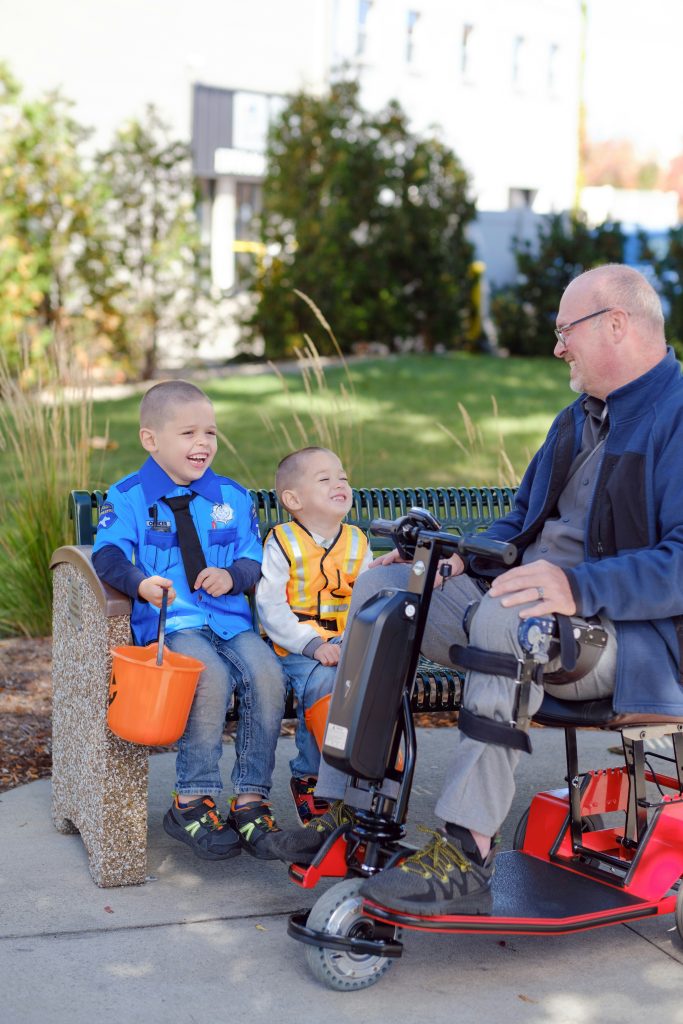GIO Enclosed Mobility Scooter | Full Review, Features & Performance (2024) highlights an all-season enclosed scooter that gives you car-like comfort and weather protection so you can regain freedom for errands, pet rides, or giving a friend a lift. The spacious interior and high weight capacity make daily outings easy and stylish.
You’ll find a full review covering features, interior space, behind-the-driver bench, performance testing, pros and cons, and buying considerations to help you decide if this luxurious enclosed model (previously named GIO Golf) fits your lifestyle across the USA and Canada.
Product overview and model background
All Season Enclosed scooter identity and 2024 positioning
You’re looking at the All Season Enclosed scooter from GIO Mobility, positioned for 2024 as a lifestyle-focused, weather-resistant step up from a conventional mobility scooter. GIO markets this model as a compact, fully enclosed personal vehicle that blends the maneuverability and simplicity of a scooter with the comfort and protection of a small cabin. For 2024 the emphasis is on year-round usability — rain, wind, sun and cooler weather are all intended to be less of a barrier to your mobility, so you can run errands, transport a companion or pet, and cruise with greater privacy and comfort.
Previous name and evolution (formerly GIO Golf)
You may see references to this product under its former name, GIO Golf. The name change to All Season Enclosed reflects the evolution from a niche leisure/short-course vehicle toward a broader mobility market. The evolution brought refinements in enclosure design, interior comfort, and accessory options so the product reads less like a novelty and more like a practical micro-mobility solution for everyday use.
Manufacturer: GIO Mobility — company profile and reputation
GIO Mobility is a manufacturer known for a range of mobility scooters and small electric vehicles aimed at personal transportation, particularly in North American markets. They’ve built a reputation around offering feature-rich, value-oriented vehicles with dealer networks and service support in many regions. If you’re considering this scooter, you’ll appreciate that GIO tends to focus on practical features — enclosed cabins, seating options, and accessories — while keeping price points competitive compared with automotive alternatives.
Intended users and typical use scenarios
This vehicle is intended for people who want greater comfort and weather protection than a conventional open mobility scooter, but who don’t need or want a full-sized car. Typical use scenarios include short local errands, neighborhood rides, transporting a friend or pet in town, community and campus mobility, and recreational cruising. If you value protection from the elements and easy ingress/egress but need something smaller and less expensive than a car, this model is aimed at you.
Key selling points highlighted in marketing and video content
Marketing and video content focus on the All Season Enclosed scooter’s enclosed cabin, perceived luxury compared with open scooters, a spacious interior with a behind-the-driver bench, and a high weight capacity for carrying passengers or cargo. Videos emphasize weather protection, the privacy of a cabin, and the freedom to move around locally without worrying about rain or cold. Ease of use, the fun and relaxed riding experience, and an attractive, car-like aesthetic are commonly highlighted.
Exterior design and build quality
Overall footprint and exterior dimensions
From the outside you’ll notice a compact footprint that balances cabin space with maneuverability. The scooter is designed to be narrower than most passenger vehicles so you can navigate tight sidewalks, driveways and parking areas comfortably. Exact dimensions vary by configuration, but you can expect a short overall length and modest width that make urban and suburban use practical — typically similar to other enclosed three- or four-wheel mobility scooters.
Materials used for body, frame and canopy
GIO typically uses a mix of lightweight metal framing (steel or aluminum) and molded plastic or fiberglass body panels for exterior surfaces. The canopy and roof are usually made from durable molded materials that resist UV and moisture, while the structural frame is designed to support the cabin and seating loads. These materials aim to balance weather resistance with manageable weight and reasonable durability.
Panel fit, finish and paint options
Panel fit and finish on GIO vehicles are generally set up for consumer use rather than premium automotive standards. Joints and seals are designed to be serviceable and durable for daily use. Paint and finish options often include a small palette of solid colors and metallics; custom paint is typically not standard, but dealer options and aftermarket paint can give you more personalization.
Door and window design including seals and weatherproofing
Doors are usually simplified for easy access — often swing doors or sliding doors depending on the configuration — and they are fitted with rubber weather seals to keep out drafts and moisture. Window designs focus on basic weatherproofing and visibility, with seals that are intended for all-season protection rather than automotive-grade watertightness. You should inspect seals regularly for wear, especially if you use the scooter in heavy rain or snow.
Visibility and sightlines from outside the cabin
From the outside, the cabin shape is intended to offer decent sightlines for the driver and visibility for others. Large windows and relatively vertical glass panels allow you to see and be seen. The profile is compact enough to keep blind spots limited, though, as with any small vehicle, you’ll want to rely on mirrors and optional cameras for tighter maneuvers.

Enclosed cabin and weather protection
Full enclosure features: doors, windows, and seals
The primary advantage you’ll notice is the full enclosure: doors to enter and exit, multi-panel windows to provide visibility, and rubber seals to limit wind and rain penetration. The enclosure is engineered so you can ride in inclement weather without the ambient exposure you’d get on a normal scooter. Door hardware is kept simple and robust for easy operation.
Protection from rain, wind, sun and cold conditions
You’ll be much better protected from precipitation, wind chill, and direct sun with the enclosed cabin. The cabin reduces wind noise and drafts, and it allows you to stay drier and warmer than an open-seat scooter. For very cold climates, the enclosure helps retain heat from the occupant and optional heaters, while in hot sunny weather it provides shade and more control over ventilation.
Window types: fixed, sliding, removable or tempered glass
Window configurations vary by trim and options. Some windows are fixed for structural rigidity, others slide for ventilation, and some panels may be removable to allow greater airflow or service access. Tempered glass or laminated polycarbonate options may be offered depending on model and region; these materials balance clarity with impact resistance. If impact resistance and scratch resistance matter to you, ask the dealer which window materials come standard or can be upgraded.
Cabin insulation and sound dampening considerations
The cabin offers basic insulation against wind and noise compared with an open scooter. Sound dampening is typically limited — you’ll still hear road and motor noise more than you would in a car — but the enclosure reduces wind noise and makes conversations easier. For extended trips or quieter operation, consider aftermarket insulation and additional seals to reduce vibration and sound transmission.
Optional climate features (heaters, fans) and aftermarket upgrades
GIO and third-party suppliers often offer optional climate comfort features such as cabin heaters, internal fans, and defogging systems. These are useful for extending comfortable use into cooler months and damp conditions. Aftermarket upgrades might include heavier insulation panels, upgraded ventilation, or even electric seat warmers. When adding accessories, ensure the scooter’s electrical system can support them and that installation preserves weatherproofing.
Interior layout and comfort
Driver cockpit layout and ergonomics
You’ll find a straightforward driver cockpit designed for intuitive operation. Controls are positioned within easy reach, and the seating position is upright for visibility and comfort. The dashboard/interface is typically simplified — you’ll have the essentials like speed indication, battery state-of-charge and basic controls — arranged so you can focus on driving rather than fiddling with complex systems.
Seating configuration: driver seat and behind-driver bench
One of the scooter’s defining features is the behind-the-driver bench that lets you carry a passenger or extra cargo. The bench is meant for short to mid-length trips and provides a convenient alternative to single-seat scooters. The driver’s seat is separate and typically more supportive, while the rear bench is simpler in design but roomy enough for an extra person or pet.
Seat materials, cushioning and adjustability
Seat materials tend to be durable vinyl or upholstery designed to resist weather and wear. Cushioning balances comfort with firm support to prevent bottoming out on longer outings. The driver’s seat may offer limited fore-aft or backrest angle adjustments; the rear bench is usually fixed but designed to be comfortable for casual rides. If you need more lumbar support or premium upholstery, check for upgraded seating packages.
Legroom, headroom and overall spaciousness
Inside, you’ll notice more headroom and legroom than on many open scooters, thanks to the cabin design. The compact footprint is used efficiently so both driver and passenger have reasonable space. Taller occupants should test the cabin for head clearance and leg comfort during a test ride, but most users find the space comfortable for errands and short trips.
Interior storage pockets and convenience features
Practical storage is incorporated into the cabin with door pockets, dash cubbies, and under-seat or rear cargo areas. You can stow small items like a purse, shopping bags, or pet supplies. Convenience features may include cup holders, a small glovebox, and tie-down points for securing cargo on the rear bench.

Weight capacity and payload
Gross vehicle weight rating and recommended payload limits
GIO markets the All Season Enclosed scooter with a higher-than-average payload capacity compared to smaller mobility scooters. While exact Gross Vehicle Weight Rating (GVWR) depends on model and options, vehicles in this category typically accommodate two occupants plus cargo within a GVWR designed for safe operation. You should consult the official spec sheet for the precise GVWR and adhere to the manufacturer’s recommended payload limits for safety and performance.
Passenger capacity and weight distribution guidance
You can carry a passenger on the behind-the-driver bench, and GIO’s design aims to distribute weight over a stable platform. When carrying passengers, place heavier items low and centered to maintain balance. Avoid overloading the rear bench; keep passenger weight within the specified seat and vehicle limits and ensure even distribution front-to-rear when possible to preserve handling.
Impact of payload on performance and range
Adding passengers and cargo will affect acceleration, hill-climbing ability and electric range. Heavier loads demand more motor power and battery energy, reducing range and making ascents slower. If you plan frequent heavy loads, expect shorter range and reduced top speed under full payload — plan trips accordingly and consider upgrading battery capacity if available.
Seating and bench design for carrying a passenger or pet
The rear bench is designed for casual passenger use and is pet-friendly for small to medium animals. For pet transport, you may want to add a secured carrier or tether points to keep your animal safe and prevent distraction. If carrying a human passenger, ensure both seats have adequate weight support and that safety restraints (if provided) are used.
Cargo-carrying recommendations and limits
Light grocery trips, small packages and personal items are ideal for this scooter. Use the rear bench and designated cargo areas for storage and avoid stacking heavy loads high or unsecured. If you anticipate frequent cargo runs, invest in accessory cargo boxes or racks rated for the scooter to keep loads stable and within manufacturer limits.
Motor, drivetrain and performance
Motor type and nominal horsepower or wattage (manufacturer specs)
GIO generally equips its enclosed scooters with electric hub or chassis-mounted motors supplied in nominal wattage ranges common to mobility vehicles. These motors commonly fall within a broad range (for example, in the several hundred to low thousands of watts). Manufacturer specifications will list the exact nominal wattage for the model you’re considering; check the spec sheet to see the motor rating and how it matches your needs for speed and load-carrying.
Drive configuration (rear-wheel/front-wheel/chain/belt)
Drive layouts for this class of vehicle are typically rear-wheel drive with the motor integrated into the rear axle or delivered through a chain/belt to the drive wheel. Rear-wheel drive provides traction under load and simplifies packaging under the vehicle. Confirm the exact drivetrain on your chosen configuration, especially if you expect to encounter steep grades or unpaved surfaces.
Acceleration characteristics and usable torque for hills
Acceleration is generally tuned for smooth, safe starts rather than rapid performance. Torque delivery is geared toward low-speed pulling power to handle inclines and payloads. You’ll notice adequate torque for neighborhood hills and stop-and-go streets, though very steep grades or heavy loads will slow acceleration and may require planning around route selection.
Top speed and speed mode options (governed settings)
Top speeds are usually governed for safety and to comply with local mobility vehicle regulations. Expect maximum speeds suitable for neighborhood use rather than highway speeds. Many models offer speed modes — an economy or restricted mode for pedestrian-like speeds, and a higher mode for quicker travel — which you can toggle depending on your comfort and local rules.
Behavior under load and on inclines
Under load and on inclines, the scooter will take longer to accelerate and may exhibit reduced top speed. The motor and gearing are designed to prioritize torque over outright speed, but very steep or sustained climbs will demand more from the battery and motor. If you frequently encounter hilly terrain, consider testing the scooter on similar slopes during a test ride to ensure it meets your expectations.

Battery, range and charging
Battery chemistry, capacity and physical placement
Battery options for enclosed scooters commonly include sealed lead-acid batteries as standard with lithium-ion upgrades offered on some trims or as dealer-installed options. Battery packs are typically placed low in the chassis or under the seat to maintain a lower center of gravity and better handling. Consult the spec sheet for precise chemistry and amp-hour ratings for the exact range and weight.
Manufacturer-rated range and real-world range expectations
The manufacturer will list a rated range under ideal conditions; however, real-world range is usually lower. Expect actual range to vary significantly with payload, terrain, temperature and driving style. As a rule of thumb, assume the real-world range will be 60–80% of the manufacturer’s ideal-cycle rating unless you test it yourself under your typical conditions.
Charging time, onboard charger specs and plug type
Charging times depend on battery chemistry and onboard charger capacity. Lead-acid packs will take longer to reach full charge than lithium-ion systems. Most scooters include an onboard charger compatible with standard household outlets, and charge times can range from several hours for a fast lithium system to longer for larger or lead-acid sets. Check the manufacturer’s charger specification for volts and amperage to plan charging cycles.
Removable battery options and hot-swap possibilities
Some configurations offer removable battery modules for easier charging or replacement. Removable batteries let you bring a charged pack indoors for convenient charging and can extend usable range with a spare pack. Hot-swapping while on the move is generally not recommended without proper procedures and safety measures; consult your dealer if you need a multi-battery solution.
Factors that affect range: temperature, payload, terrain and driving style
Expect range to drop in cold temperatures, under heavy payloads, on hilly routes, and with aggressive acceleration. Using climate accessories like heaters will also draw from the battery and reduce range. To get predictable performance, test the scooter in the conditions you plan to use it and adopt a conservative estimate for planning trips.
Controls, instruments and user interface
Steering mechanism: cockpit tiller vs steering wheel options
Different enclosed scooter designs use either a compact steering wheel or a tiller-style steering column. The All Season Enclosed scooter typically mimics car-like controls with a small steering wheel for familiarity, though some trims or regions may offer simpler tiller controls. You’ll prefer a steering option that suits your comfort and mobility needs, so request both options if available.
Dashboard/instrument cluster: speedometer, state-of-charge and indicators
The dashboard is designed around clarity and simplicity. You’ll typically find a speedometer, an obvious state-of-charge indicator (battery gauge), and warning indicators for lights, faults or low battery. The instrument cluster is user-oriented so you can monitor range and vehicle status at a glance.
Control switches: lights, wipers, horn, turn signals
Essential switches for lights, wipers and horn are within easy reach and shaped for tactile use so you can operate them without looking away from the road. Turn signals are standard and often automatically cancel or can be manually cancelled, and basic wiper functions and lighting controls help keep the cabin usable in mixed weather.
Lighting package: headlights, taillights, brake lights and indicators
Lighting packages commonly include halogen or LED headlights, taillights, brake lights and turn indicators to meet local safety requirements. Daytime visibility and nighttime illumination are typically adequate for neighborhood driving; if you intend to operate in low-light or unlit areas often, prioritize LED upgrades and aim for the brightest available headlight option.
User-accessible diagnostics and smart features (if available)
The scooter’s user interface may provide basic diagnostics such as fault indicators and battery status, but comprehensive diagnostics are commonly accessed through dealer tools. Some modern models offer simple smart features like key fob start, immobilizer, or optional telematics, but availability varies by trim and market. Ask the dealer about smartphone connectivity or remote diagnostics if those are important to you.

Safety systems and stability
Braking system: type, braking distances and parking brake
Braking systems on these scooters are generally hydraulic or mechanical disc/drum systems sized for the vehicle’s speed and weight class. Braking distances are suitable for neighborhood speeds; however, stopping distance will increase under heavier loads and wet conditions. A manual parking brake or electronic park function is usually included to secure the vehicle when parked.
Stability features: wheelbase, low center of gravity and anti-tip design
Stability comes from a compact wheelbase, low-placed batteries and seating that keep the center of gravity down. If the model has three wheels, anti-tip geometry is often used; four-wheel versions inherit the intrinsic stability of the axle layout. Be mindful that very sharp turns at speed can still cause instability; operate within recommended speeds for safety.
Active safety items: indicators, mirrors, horn and lighting compliance
Active safety items such as turn indicators, mirrors, horn, and compliant lighting are standard to help you communicate and be seen. Mirrors are adjustable and essential for situational awareness. Check local regulations to ensure the scooter meets any required equipment rules for operation on sidewalks, private property, or local roads.
Passive safety: seat belts, cabin structure and weatherproofed exits
Passive safety includes the cabin structure and available seat belts or restraint options. Not all mobility scooters come with seat belts as standard, so if restraints matter to you, confirm availability. The cabin is built to shed weather and provide structural support for daily use, and exits are designed to be accessible and quick to open in case you need to leave the vehicle.
Visibility aids: mirrors, optional backup camera or sensors
Standard mirrors help with lane and rear visibility, and many users opt for optional visibility aids like backup cameras or parking sensors to ease maneuvers in tight spaces. These options are particularly helpful if you regularly park in compact areas or carry passengers who require additional safety considerations.
Conclusion
Final assessment of the GIO Enclosed Mobility Scooter for 2024
Overall, the GIO All Season Enclosed scooter for 2024 is a compelling option if you want a weather-protected, compact personal vehicle that bridges the gap between open mobility scooters and cars. It brings practical enclosure features, a roomy interior for its class, and useful payload capacity while remaining easy to drive and inexpensive to operate compared with full-size vehicles.
Who will benefit most from this model and why
You’ll benefit most from this model if you want year-round mobility without exposure to the elements, need the ability to carry an occasional passenger or pet, and prefer a simple, intuitive vehicle for short community trips. It’s ideal for neighborhood errands, campus commutes, seniors seeking independence, and anyone prioritizing convenience over high speed or long-distance travel.
Top considerations before purchasing and next steps (test ride, dealer visit)
Before you buy, test-ride the scooter with typical payloads (yourself plus passenger or cargo) and on the routes you’ll use. Confirm the exact motor, battery capacity, GVWR and warranty details with the dealer. Check local regulations about where you can legally operate the vehicle, and ask about accessory options for heaters, upgraded batteries, and visibility aids.
Where to find official specs, dealer contacts and the GIO Mobility video resources
For the most accurate and detailed specifications, warranty terms and dealer contacts, get the official spec sheet from GIO Mobility or speak directly with a local authorized dealer. GIO often produces video resources and walkthroughs that demonstrate features and real-world use; watching manufacturer videos and in-person demos will give you the clearest sense of fit and function for your needs.
Closing recommendation and summary action points for prospective buyers
If you want increased comfort, weather protection and a simple way to move around locally, this enclosed scooter is worth serious consideration. Next steps: schedule a test ride, confirm load and range specifications under your typical conditions, check accessory and battery upgrade options, and verify dealer service and warranty support. Do that, and you’ll be well positioned to decide whether the All Season Enclosed scooter is the right mobility solution for your daily life.
Shop here: for the US and for Canada
Need a scooter but miss the comfort and protection from the elements of a car?
Look no further than the All Season Enclosed scooter (previously named GIO Golf) from GIO Mobility. Our luxurious fully enclosed scooter will help you regain your freedom without worrying about the weather. Ride in style with all the best features of a scooter combined with the perks and seclusion of a car cabin. The spacious interior, high weight capacity and behind the driver bench makes running errands, cruising with a pet, or giving a friend a ride, a breeze!



